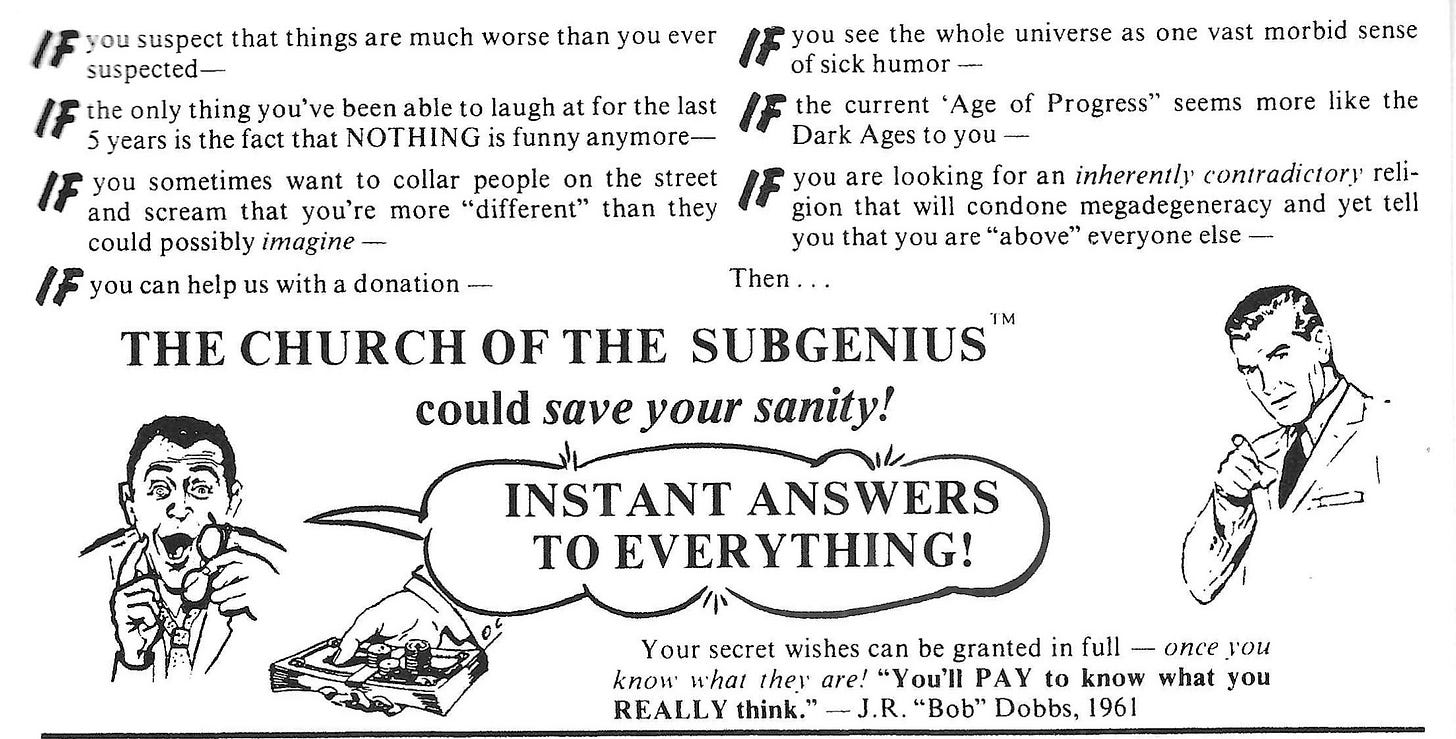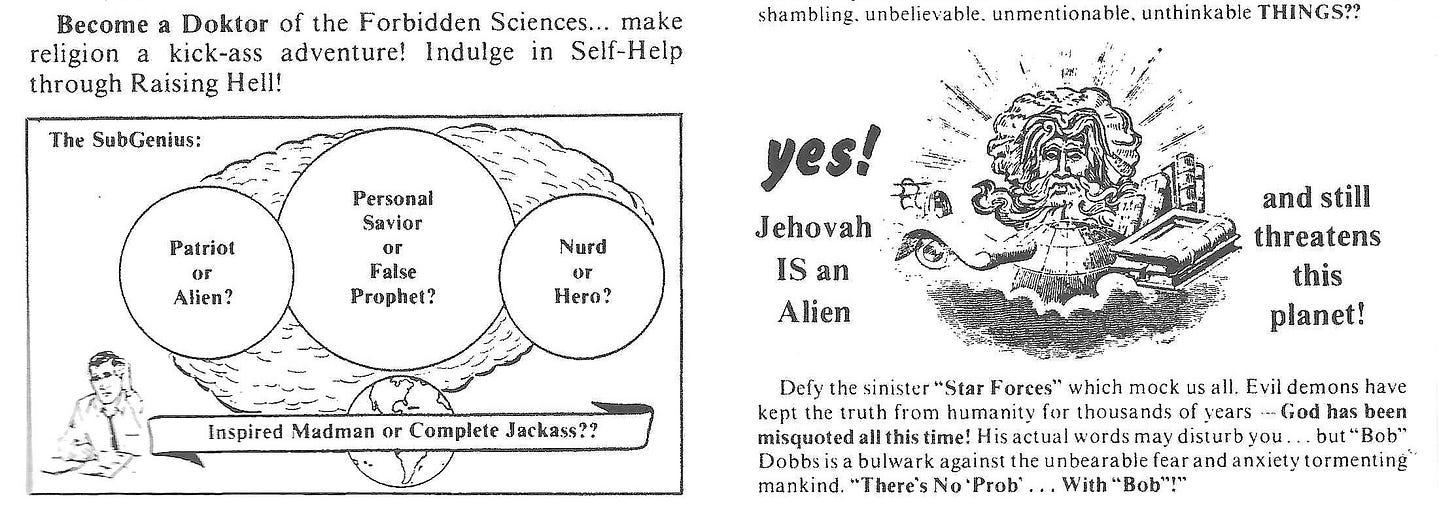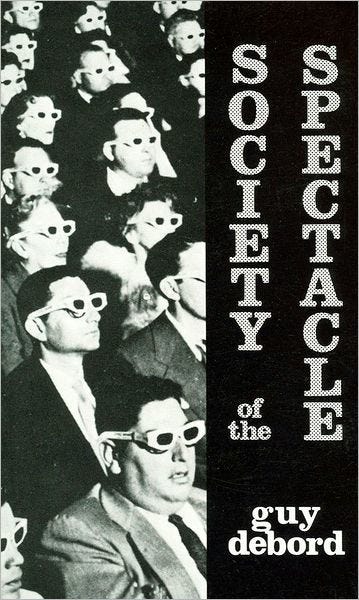Let's Visit the World of the Future
how the greatest work of Firesign fan art created the Church of the SubGenius
Some quick announcements
On February 7, David Suisman and I will be talking to each other about our new books and doing a signing at People’s Book in Takoma Park, MD. Would love to see anyone in the DC area there.
And there was another nice review of Firesign: The Electromagnetic History of Everything, this one from Ron Jacobs in Counterpunch.
The Church of the SubGenius and the Situationist International
Today we’re talking about the unlikely career of a 45-minute student film made at Southern Methodist University in 1973 . Shot on 16mm black-and-white film by Dallas native Douglass St. Clair Smith, and featuring an impressive cast of amateur actors, animation artists, and malevolent clowns (all of them presumably friends), Let’s Visit the World of the Future is also one of the most interesting and fully realized examples of Firesign Theatre fan art.
Easily found today on YouTube (scroll to the bottom for the link), Let’s Visit the World of the Future can be seen as a trial run for the Church of the SubGenius, the famous apocalyptic anti-consumerist “parody religion” that Smith founded a few years later pseudonymously as the Reverend Ivan Stang. The Church of the SubGenius (or Church of “Bob”) gained thousands of adherents through the 1990s and 2000s, some of whom took the church quite seriously — a fascinating combination sociology of belief and satire. You can still become one of the Church’s ordained ministers today, for only $44.99!
The sociologist Carole M. Cusack has described the SubGenius theology — expressed through its numerous print publications, radio programs, internet culture, public gatherings — as comprising one one hand a “dramatic UFO mythology”1 that is an obvious satire of the Church of Scientology, and on the other hand a brutally literal critique of capitalist consumer culture as a Conspiracy that controls humanity and has transformed the known world into an impoverished sham fiction. Note the obvious, gleeful bullshit of the first image, below (Jehovah IS an Alien and still threatens this planet!), followed by the second graphic, which could be read almost completely literally (“if the current ‘Age of Progress’ seems more like the Dark Ages to you”):

Cusack has pointed out that this second strain of SubGenii doctrine bears a striking resemblance to the writings and actions of the Situationist International, the group of young French avant-garde intellectuals who played a central role in the May ’68 uprising (“sous les Pavés, la Plage!”) and whose thought was crystalized in the 1967 book Society of the Spectacle by Guy Debord. Arranged as a series of statements that can be read sequentially or at random, Society of the Spectacle is itself concerned to describe a social reality transformed and dominated entirely by the commodity and its images:
#6 The spectacle […] is the heart of the unrealism of the real society. In all its specific forms, as information or propaganda, as advertisement or direct entertainment consumption, the spectacle is the present model of socially dominant life. It is the omnipresent affirmation of the choice already made in production and its corollary consumption.
#18: When the real world changes into simple images, the simple images become real beings and effective motivations of hypnotic behavior.
#20: Philosophy, the power of separate thought and the thought of separate power, could never by itself supersede theology. The spectacle is the material reconstruction of the religious illusion.2
As Cusack rightly observes, the Church of Bob’s “Conspiracy” is synonymous with Situationtionism’s “Spectacle.”3 This is also the idea that Douglass St Clair Smith, together with his friends, memorably dramatized in Let’s Visit the World of the Future. But while it is possible that the 1973 film was directly inspired by Society of the Spectacle (the book had appeared in an English translation three years earlier from the radical Detroit publisher Black & Red), what is certain — and Smith acknowledges his debt in the credits — is the explicit homage the film makes to the Firesign Theatre.
Let’s Visit the World of the Future / the greatest work of Firesign fan fiction


With its emphasis on a world of holograms, ultra-administered environments, concern for the “future,” and above all its population of clowns, Let’s Visit the World of the Future obviously extends the iconography of Firesign’s 1971 album I Think We’re All Bozos on This Bus (though Smith’s “Bozos” are belligerent representatives of what the SubGenii will dub the Conspiracy). The film is presented as an anodyne travelogue — “I’ll be your guide on this trip through reality, and on this trip I can make you see anything I want you to see” … a world where “one is made to enjoy life!” — narrated by an ingratiating voice above a bubbling current of Muzak (which is also duly credited). In these respects it also resembles the eerily muted Bozos album.






But because Smith’s “world of the future” is unmistakably an image of the present, and because that image serves its critique of mandatory consumerism (and work), it is equally indebted to Firesign’s 1970 album Don’t Crush That Dwarf, Hand Me the Pliers, which is set ambiguously in an authoritarian near-future/alternate present where lonely citizens watch themselves on television, in between bombarding advertisements for Napalmolive dish soap, and receive food directly through their television screens.
One nifty sequence that yokes these together is the cross-cutting between the escalators in a shopping mall and a guy standing stoically as he is carried along on the conveyor belt of an airport baggage claim — together recalling the “yellow rubber line” of Bozos’ “Wall of Science” sequence as well as grotesque parodies of consumption throughout Dwarf.



As these sequences show — as do several others shot, guerilla-style, in shopping malls and five-and-dime stores — this piece of acknowledged Firesign fan art is in fact much closer to the first-generation Situationists than would be its successor, the Church of the SubGenius. And although the Firesign Theatre did not to my knowledge know Society of the Spectacle, a different fan collective — the London-based group that produced a fanzine titled Trailing Clouds of Glory — made this very connection when they appended a bibliography of Situationist publications at the end of their long 1974 appreciation of the Firesign Theatre for UK audiences.4


from Firesign to SubGenius and after
Two years later, in 1975, Doug Smith was among the most active of the hundreds of fans collaborating in the Papoon for President campaign (which I discussed in an earlier post), which semiseriously ran the Firesign Theatre character George Papoon for president in the 1976 election. Coordinator of Dallas’s Bulldada Time Control Labs Papoon Cocoon, Smith wrote informed articles on Dada and Surrealism for The Toiler fanzine and was invited to screen Let’s Visit the World of the Future at the Lawrence, Kansas Papoon convention, a performative get-together that likely inspired the later annual “Devivals” of the Church of the Bob. It was three years after Papoon’s unsuccessful bid for the presidency, that Smith (as the Reverend Ivan Stang) used the national Papoon mailing list to launch the Church of the SubGenius with the Pamphlet #1 — The World Ends Tomorrow and You May Die! (1979).
Watching Let’s Visit the World of the Future today (which I very highly recommend), it is impossible not to want a similar participatory critique of the whole world for 2025 — and to wonder what media forms in could take. Rather than ending on that note, though, it’s worth noticing the ways in which this critique of “capitalist realism” found other forms, that reached semipopular and even mainstream audiences through the 1980s, whether in the form of very early Devo (who later became Church of Bob adherents), or in John Carpenter’s fantastic and underappreciated film They Live (1988).
Today I was furtively watching clips from They Live — and wishing we had a wrestler like that on our side today — I came across the sequence in which Roddy Piper and Keith David crash a stockholders meeting of capitalist/aliens to hear the pronouncement: “Our projections show that by the year 2025, not only America but the entire planet will be under the protection and the dominion of our power alliance. The gains have been substantial, both for ourselves and for you — the human power elite.” It was quite bracing to see the aliens communicating to each other through their watches, while Roddy Piper’s glasses show him the truth in real black and white. Guys, I’m all out of bubblegum!
without further ado, Let’s Visit the World of the Future (dir. Douglass St. Clair Smith, 1973)
“[W[hich involves,” in Cusack’s words, “Atlantis and its Yeti inhabitants; ‘Bob’ Dobb’s ability to die and return to life multiple times; the genetic engineering of the SubGenii (who are part-human and part-Yeti); the vengeful god Jehovah-1 (known also as WOTAN and many other divine names), whose purpose is to deprive people of the mythical quality of ‘Slack’; the Elder Gods of Lovecraft’s Cthulhu mythos and their robot agents the Watchers, who appear as UFOs or ‘flying saucers;’ the Conspiracy, which seeks to control everyone and render them powerless; and the extraterrestrial race of Xists, who created the Yetis and who will arrive in spacecraft to save their descendants the SubGenii on July 5 1998, known as X-Day or the ‘Rupture,’ a pun on the Rapture of dispensationalist premillenarian Protestantism.” Carole M. Cusack, “The Messiah is a Salesman, Yet Consumerism is a Con(spiracy): The Church of the SubGenius, Work, and the Pursuit of Slack as a Spiritual Ideal,” Nova Religio 19.2 (2015): 51.
Guy Debord, The Society of the Spectacle, trans. Fredy Perlman (1967; Detroit: Black and Red, 1983).
Drawing the lines even closer together, the epigraph to Society of the Spectacle are these lines from Feuerbach’s Essence of Christianity: “But certainly for the present age […], the appearance is the essence […] illusion only is sacred, truth profane. Nay, sacredness is held to be enhanced in proportion as truth decreases and illusion increases, so that the highest degree of illusion comes to be the highest degree of sacredness.”
I discuss this further (with a killer illustration) in the preface to Firesign: The Electromagnetic History of Everything as Told on Nine Comedy Albums.






My audio tribute to Peter Bergman from 2012 (part of my Golden Ego Radio series) includes comments from Rev. Stang's "Hour of Slack" show in which he says there would be no Church of the SubGenius without the Firesign Theatre.
I've serialized those two tribute shows and will be posting them soon on Bluesky, with links to the audio. I still have my "ordained ministers" kit from Stang, though it was cheaper back in the day.